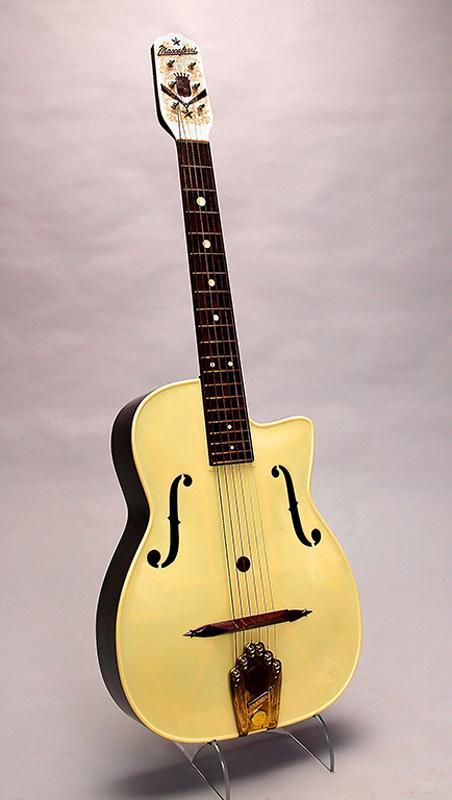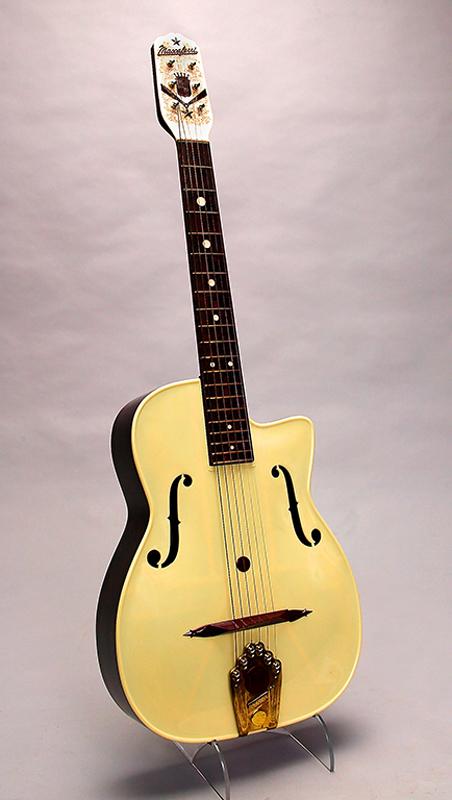Advanced Search
Plucked Strings
Guitars
Guitar
Maker: Mario Maccaferri
Date: 1953-1964 ca.
Place Made:New York, New York, United States, North America
Model: DeLuxe Arched Top / G40
Serial No: none
SignedLogo on peghead in red plastic letters: Maccaferri
MarkingsOn red plastic shield on peghead: M / M
DescriptionMario Maccaferri, a former concert guitarist and French reed maker, immigrated to the United States in 1939. While he continued his reed making in the United States, difficulty obtaining the reed itself led him to devise reeds made from plastic, a material that caught his attention at the New York World’s Fair in 1939. He filed a patent application for the novel reeds in 1941, and it was awarded the following year. Maccaferri soon began producing other plastic consumer products, including clothespins, hangers, plastic tiles, acoustic tiles, and later 8-track and cassette housings. Before the war, Maccaferri had designed a guitar for Selmer, Paris, which became famous as the guitar of choice for jazz artist Django Reinhardt. In 1949, Maccaferri combined his interests in musical instrument design with his expertise in plastic to produce the Islander Ukulele, the first plastic stringed instrument. Priced at an affordable $5.95, the instruments were highly commercially successful. In 1953, Maccaferri introduced his plastic guitars, which were not meant to be a cheap substitute for a wood guitar, but rather a highly functional instrument that happened to be constructed from plastic. In 1964, the name of the company was changed from French American Reeds Manufacturing Company to Mastro Plastics Corporation. By 1969, criticism and slow sales caused Maccaferri to cease production of his plastic instruments, the rights to which were sold to Carnival Industries, which never elected to manufacture the instruments. Following his retirement in 1981, Maccaferri continued pursuing his interest in plastic instruments with the development of a plastic violin, which premiered at Carnegie Hall in 1990. Maccaferri died three years later at the age of 92.
The G40 is a small-sized archtop cutaway made from Dow Styron. The fan bracing of the top differed from most wood archtops of the period, which either had X-bracing or parallel bars. While his Islander Ukuleles were made to appeal to professionals, amateurs, and children alike, Maccaferri’s Styron guitars were intended to be serious musical instruments and a legitimate alternative to the wood guitar, which is sensitive to changes humidity, unlike the plastic instrument. Maccaferri struggled for many years against the perception that his guitars were merely “toys” due to the material from which they were made.
Date: ca. 1953 - 1964 (Maccaferri introduced his plastic guitar in the spring of 1953 and ceased its production in 1969. The company name was changed to Mastro Industries in 1964. The promotional materials suggest the instrument was made before this time, since they refer to the French American Reeds Manufacturing Company. Michael Wright, "Maccaferri History . . .," copy in file)
Top: Dow Styron, arched-top, wood-braced top
Back and sides: One piece Dow Styron shell
Neck: The neck is bolted on with a slight cutaway at the treble side of the neck. The outside of the neck consists of two pieces of plastic, the outer back and then the fingerboard. The fingerboard bares actual metal frets (twenty in number) and white position markers (these markers are actually part of the back of the neck and give us an idea of how the parts are aligned). Inside of neck consists of a metal sheath, that is referred to as an "armored neck," and the core is a piece of wood. These two elements were designed to guarantee that the neck should never warp.
Peghead: Ornate peghead with six banjo style tuners with 14:1 gear ratio
Fingerboard: See neck description
Bridge: Dow Styron fixed bridge
Tailpiece: Metal with plastic Maccaferri logo
Decorative Elements: Guitar body is made of ivory-white plastic. Guitar neck has a red tortoise shell coloration. See neck details above. Ornate decoration on peghead face. Tailpiece is brass plated. Red plastic button with letter M on the top between the sound holes. Bridge is colored red and contrasts to the white top.
The G40 is a small-sized archtop cutaway made from Dow Styron. The fan bracing of the top differed from most wood archtops of the period, which either had X-bracing or parallel bars. While his Islander Ukuleles were made to appeal to professionals, amateurs, and children alike, Maccaferri’s Styron guitars were intended to be serious musical instruments and a legitimate alternative to the wood guitar, which is sensitive to changes humidity, unlike the plastic instrument. Maccaferri struggled for many years against the perception that his guitars were merely “toys” due to the material from which they were made.
Date: ca. 1953 - 1964 (Maccaferri introduced his plastic guitar in the spring of 1953 and ceased its production in 1969. The company name was changed to Mastro Industries in 1964. The promotional materials suggest the instrument was made before this time, since they refer to the French American Reeds Manufacturing Company. Michael Wright, "Maccaferri History . . .," copy in file)
Top: Dow Styron, arched-top, wood-braced top
Back and sides: One piece Dow Styron shell
Neck: The neck is bolted on with a slight cutaway at the treble side of the neck. The outside of the neck consists of two pieces of plastic, the outer back and then the fingerboard. The fingerboard bares actual metal frets (twenty in number) and white position markers (these markers are actually part of the back of the neck and give us an idea of how the parts are aligned). Inside of neck consists of a metal sheath, that is referred to as an "armored neck," and the core is a piece of wood. These two elements were designed to guarantee that the neck should never warp.
Peghead: Ornate peghead with six banjo style tuners with 14:1 gear ratio
Fingerboard: See neck description
Bridge: Dow Styron fixed bridge
Tailpiece: Metal with plastic Maccaferri logo
Decorative Elements: Guitar body is made of ivory-white plastic. Guitar neck has a red tortoise shell coloration. See neck details above. Ornate decoration on peghead face. Tailpiece is brass plated. Red plastic button with letter M on the top between the sound holes. Bridge is colored red and contrasts to the white top.
DimensionsTotal instrument length: 935 mm (36-13/16 inches)
Vibrating string length: 620 mm (24-7/16 inches)
Fingerboard length: 425 mm (16-1/2 inches)
Width of fingerboard at nut: 47 mm (1-7/8 inches)
Width of fingerboard at body: 57 mm (2-1/4 inches)
Width of upper bout: 256 mm (10-3/16 inches)
Width of waist: 226 mm (9 inches)
Width of lower bout: 340 mm (13-1/4 inches)
Depth of body at neck: 88 mm (3-7/16 inches)
Depth of body at bottom: 88 mm (3-7/16 inches)
Vibrating string length: 620 mm (24-7/16 inches)
Fingerboard length: 425 mm (16-1/2 inches)
Width of fingerboard at nut: 47 mm (1-7/8 inches)
Width of fingerboard at body: 57 mm (2-1/4 inches)
Width of upper bout: 256 mm (10-3/16 inches)
Width of waist: 226 mm (9 inches)
Width of lower bout: 340 mm (13-1/4 inches)
Depth of body at neck: 88 mm (3-7/16 inches)
Depth of body at bottom: 88 mm (3-7/16 inches)
Terms
Credit Line: Arne B. Larson Estate
Not on view
Object number: 10458









